
This is a SUPER easy guide on Mendelevium element.
In fact, the table mentioned below is the perfect information box (Which gives you every single detail about the Mendelevium element in Periodic table.)
So if you want to know anything about Mendelevium element, then this guide is for you.
Let’s finish this very quickly.
Mendelevium Element (Md) Information
| State (at STP) | Solid (predicted) |
| Position in Periodic table | 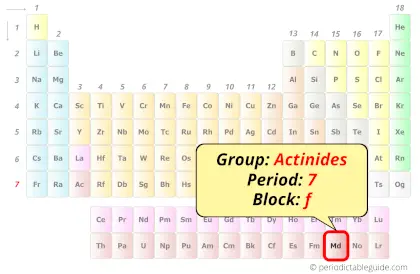 Group: actinides, Period: 7, Block: f |
| Category | 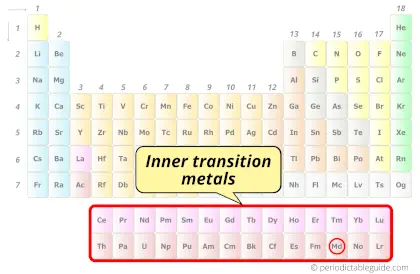 Inner transition metals |
| Atomic number or Protons | 101 |
| Neutrons | 157 |
| Electrons | 101 |
| Symbol | Md |
| Atomic mass of Mendelevium (most stable isotope) | 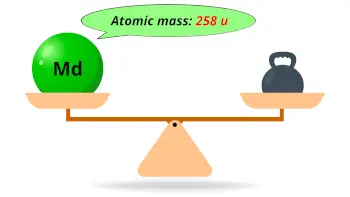 258 u |
| Electrons arrangement or Bohr model | 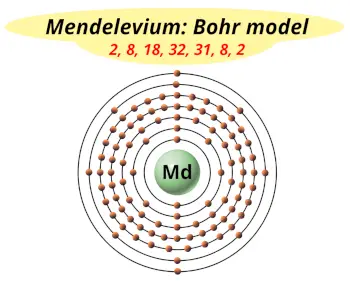 2, 8, 18, 32, 31, 8, 2 |
| Electronic configuration | [Rn] 5f13 7s2 |
| 1st Ionization energy | 6.58 eV |
| Electronegativity | 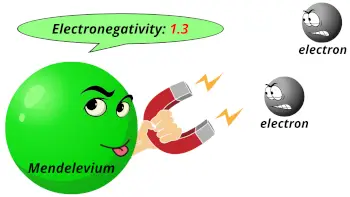 1.3 (Pauling scale) |
| Crystal structure (predicted) | 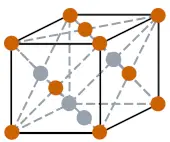 FCC (face centered cubic) |
| Melting point (predicted) | 1100 K or 827 °C or 1521 °F |
| Density (predicted) | 10.3 g/cm3 |
| Main isotopes | 258Md and 260Md |
| Who discovered Mendelevium and when? | Albert Ghiorso and his team (in 1955) |
| CAS number | 7440-11-1 |
Mendelevium in Periodic table
Mendelevium element is in period 7 and in actinides group of the Periodic table. Mendelevium is the f-block element and it belongs to inner transition metals group.
| H | He | ||||||||||||||||
| Li | Be | B | C | N | O | F | Ne | ||||||||||
| Na | Mg | Al | Si | P | S | Cl | Ar | ||||||||||
| K | Ca | Sc | Ti | V | Cr | Mn | Fe | Co | Ni | Cu | Zn | Ga | Ge | As | Se | Br | Kr |
| Rb | Sr | Y | Zr | Nb | Mo | Tc | Ru | Rh | Pd | Ag | Cd | In | Sn | Sb | Te | I | Xe |
| Cs | Ba | La* | Hf | Ta | W | Re | Os | Ir | Pt | Au | Hg | Tl | Pb | Bi | Po | At | Rn |
| Fr | Ra | Ac** | Rf | Db | Sg | Bh | Hs | Mt | Ds | Rg | Cn | Nh | Fl | Mc | Lv | Ts | Og |
| *Ce | Pr | Nd | Pm | Sm | Eu | Gd | Tb | Dy | Ho | Er | Tm | Yb | Lu | ||||
| **Th | Pa | U | Np | Pu | Am | Cm | Bk | Cf | Es | Fm | Md | No | Lr |
←Move to: Fermium (Fm) element – Periodic Table
→Move to: Nobelium (No) element – Periodic Table
Why is Mendelevium in Period 7?
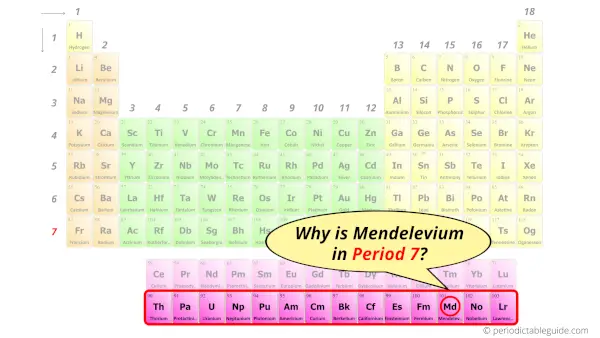
Let me ask you a question.
How many shells does mendelevium have?
It’s 7. Right?
You have already seen the bohr model of mendelevium atom in the above table.
From the Bohr model, it can be found that the number of orbits or shells in mendelevium is 7. Hence, as mendelevium has 7 orbits, it lies in period 7 of the Periodic table.
Why is Mendelevium in f-block?
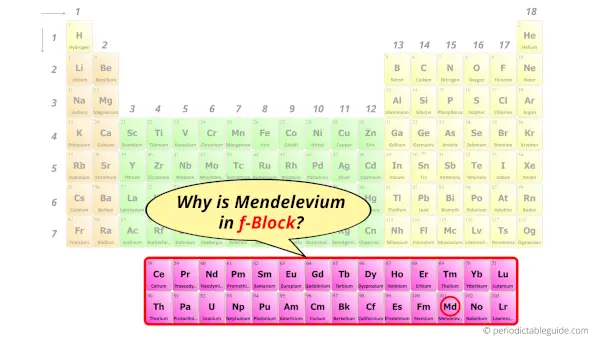
Before knowing this reason, first of all I want to ask you a simple question.
How can you determine the blocks-wise position of elements?
The simple answer: The elements will lie in the s, p, d or f block will completely depend upon the subshell in which the last electron will enter.
For example; the electron configuration of mendelevium is [Rn] 5f13 7s2.
So the last electron of mendelevium enters the f-subshell or f-orbital.
Hence, mendelevium is the f-block element.
5 facts about Mendelevium
Interesting facts about mendelevium element are mentioned below.
- The element was given the name “Mendelevium” to honor the famous chemist Dmitri Mendeleev.
- Mendelevium was discovered by Albert Ghiorso and his team (in 1955), at Lawrence Berkeley National Laboratory, California.
- Mendelevium is an artificially prepared synthetic element and it is produced in very less quantity till now.
- There are 17 known isotopes of mendelevium and all those isotopes are radioactive in nature.
- Out of all the isotopes of mendelevium, the isotope 258Md is the longest lived isotope and has a half-life of around 51 days.
Properties of Mendelevium
The physical and chemical properties of mendelevium element are mentioned below.
- Mendelevium is a radioactive element and it is harmful to living beings.
- Like other actinides, the most common oxidation states of mendelevium are +3 and +2.
- The predicted crystal structure of mendelevium is FCC (i.e face centered cubic).
- The predicted melting point of mendelevium metal is 827 °C.
- The atomic mass of the most stable isotope of mendelevium is 258 u and its density is predicted to be 10.3 g/cm3.
Uses of Mendelevium
Mendelevium element is generally used for research work in chemistry. It has no commercial uses due to its radioactive nature as well as scarcity.
Explore our New Interactive Periodic Table (with Rotating Bohr Models and More)

Details about this Periodic table:
- Access detailed info on all elements: atomic mass, electron configurations, charges, and more.
- View rotating Bohr models for all 118 elements.
- Get a free HD image of the Periodic Table.
Note: For future use, bookmark this Periodic table or visit “PeriodicTableGuide.com”
External resources:
- Mendelevium – Element information, properties and uses | Periodic Table. (n.d.). Mendelevium – Element Information, Properties and Uses | Periodic Table. https://www.rsc.org/periodic-table/element/101/mendelevium
- Mendelevium – Wikipedia. (2014, August 4). Mendelevium – Wikipedia. https://en.wikipedia.org/wiki/Mendelevium
- P. (n.d.). Mendelevium | Md (Element) – PubChem. Mendelevium | Md (Element) – PubChem. https://pubchem.ncbi.nlm.nih.gov/element/Mendelevium
- It’s Elemental – The Element Mendelevium. (n.d.). It’s Elemental – the Element Mendelevium. https://education.jlab.org/itselemental/ele101.html
- Discovery of Mendelevium – Nuclear Museum. (2017, June 9). Nuclear Museum. https://ahf.nuclearmuseum.org/ahf/history/discovery-mendelevium/
- Pichon, A. (2019, February 21). Mendelevium 101. Nature Chemistry, 11(3), 282–282. https://doi.org/10.1038/s41557-019-0227-8
